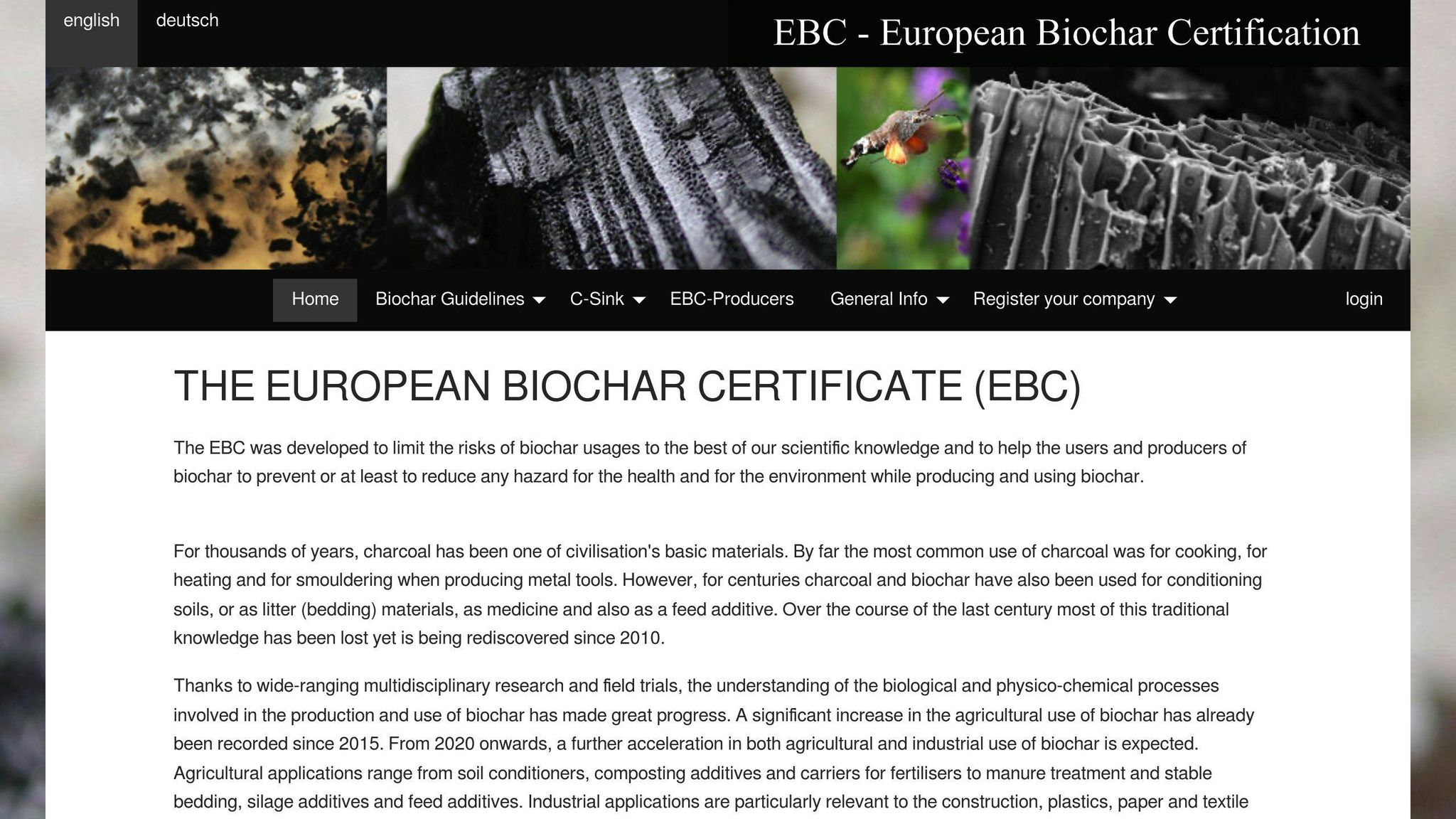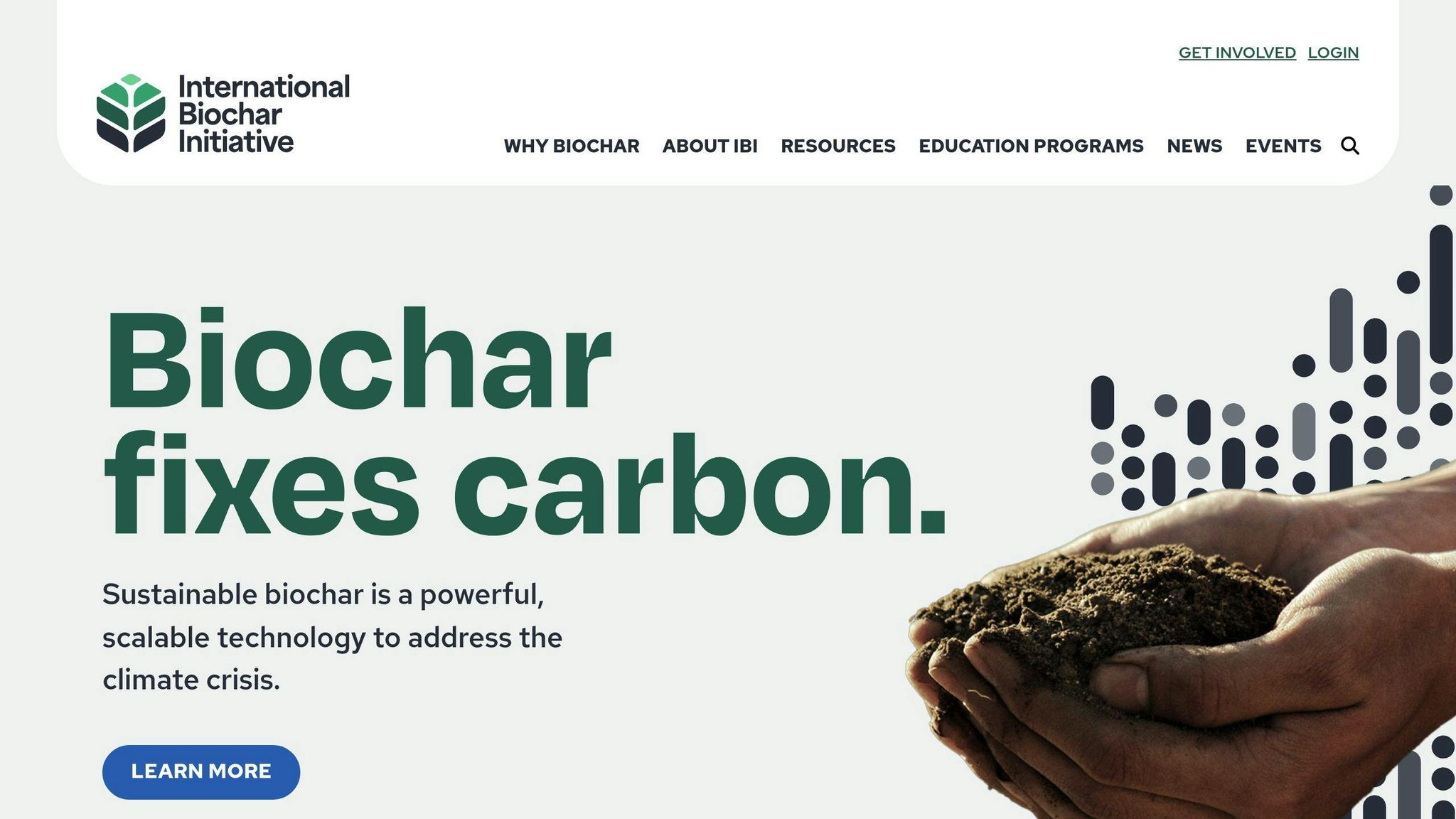: A Quick Guide
Biochar quality matters, but standards vary globally. Here's what you need to know:
- Key Standards: European Biochar Certificate (EBC) and International Biochar Initiative (IBI) Standards lead the way
- Quality Factors: Production methods, feedstock, and properties all impact biochar effectiveness
- Testing Methods: Range from basic pH tests to advanced surface area analysis
- Regulations: Vary by region - Switzerland requires EBC certification for agricultural use
- Future Trends: Expect more unified standards and increased research
| Aspect | EBC (Europe) | IBI (Global) | US Regulations |
|---|---|---|---|
| Focus | Production & quality | Soil performance | Emissions control |
| Status | Mandatory in Switzerland | Optional | In development |
| Key Feature | Strict criteria | Adaptable guidelines | Clean Air Act compliance |
Testing is crucial. Regular quality checks and following local regulations are key for biochar success.
Related video from YouTube
Biochar quality basics
What makes good biochar? It's not just about burning stuff. Let's break it down:
What affects biochar quality
Biochar quality isn't random. It depends on:
- What you burn (feedstock)
- How hot you burn it (500-700°C is best)
- How fast you heat it (slower is better)
- How long you burn it
- How dry the material is (aim for less than 15% moisture)
Production methods matter
How you make biochar changes what you get:
- Higher temps (650°C) = more alkaline biochar
- Fixed-bed reactors beat fluidized-bed for consistency
- Post-processing (like grinding) can tweak properties
Here's a real-world example: Rice straw burned at 650°C and finely sieved worked best for cleaning up vanadium-polluted soil.
Quality = Effectiveness
Better quality means better results:
| Factor | Why it matters |
|---|---|
| H/Corg ratio | Shows stability and carbon storage potential |
| pH | Affects soil acidity and nutrients |
| Carbon content | Long-term soil benefits |
| Nutrient content | Short-term soil boost |
The European Biochar Certificate says H/Corg ratio is KEY for carbon storage.
Want to lock up carbon? Aim for:
- H/Corg between 0.38 and 0.44
- Burn at 500-550°C
This locks up about 41.4% of carbon for 100 years.
In action, that finely-sieved rice straw biochar:
- Bumped up soil pH by 1.72
- Boosted organic matter by 3.80%
- Increased available phosphorus by 9.17 mg kg−1
- Cut toxic vanadium by 225.59 ± 16.25 mg per kg of soil
Bottom line: Better biochar = healthier soil and less pollution.
Global biochar standards
Biochar quality standards ensure consistency and safety. Here are the main global standards:
European Biochar Certificate (EBC)

The EBC focuses on environmental impact, soil amendment effectiveness, and key parameters. It sets strict criteria for carbon content, pH levels, particle size, and water content.
International Biochar Initiative (IBI) Standards

IBI Standards provide guidelines for production and use, emphasizing soil health and carbon sequestration. In 2023, IBI merged with Carbon Standards International (CSI) to create stronger certifications.
"As the biochar industry scales, IBI continues to work to support it with partnerships that create confidence in biochar systems." - Lucia Brusegan, IBI Board Chair
This merger combines the IBI Biochar Standard and CSI's World Biochar Certificate, aiming to boost biochar reliability and safety.
Regional standards
Some regions have their own standards:
| Region | Standard | Focus |
|---|---|---|
| Australia | ANZBI | Local feedstocks, soil types |
| China | Biochar Quality Standard | Production methods, applications |
| Japan | JBA Certification | Rice husk char, agricultural use |
These standards often adapt global criteria to local conditions and needs.
How biochar is classified
Biochar classification helps you pick the right product for your needs. Let's break it down.
Types of biochar benefits
Biochar offers several key benefits:
- Carbon storage
- Soil fertilization
- pH adjustment (liming)
- Soil structure improvement
- Use in soilless agriculture
These categories help you find the best biochar for your specific needs.
How classifications help users
Classification systems, like those from the International Biochar Initiative (IBI) and European Biochar Certificate (EBC), make it easier to understand biochar properties. Here's how they help:
1. Matching biochar to soil needs
You can pick biochar based on what your soil needs. For example:
| Soil Need | Biochar Type |
|---|---|
| Nutrient-poor soil | High fertilizer value biochar |
| Acidic soil | High liming value biochar |
| Sandy soil | Fine particle-size biochar |
2. Identifying suitable applications
The classification system shows you the best use for each biochar type:
| Biochar Class | Suitable Application |
|---|---|
| High carbon storage | Climate change mitigation |
| High fertilizer value | Crop yield improvement |
| Coarse particle-size | Soil water retention |
3. Assessing climate impact
Want to know which biochar is best for the climate? Classifications can tell you. For example, biochar with high carbon storage value is great for long-term carbon sequestration.
4. Ensuring quality and safety
Standards like the IBI Biochar Standards help you choose safe, high-quality biochar. These standards test for:
- Beneficial properties (Test Category A)
- Toxicity (Test Category B)
- Advanced soil improvement properties (Test Category C, optional)
5. Optimizing production methods
Manufacturers use these classifications to fine-tune their production. They might adjust pyrolysis temperatures (from 350°C to 800°C) to make biochar with specific properties.
In short, biochar classification takes the guesswork out of choosing the right product for your needs.
Testing biochar properties
Testing is crucial to understand biochar quality and uses. Here's an overview of key methods:
Basic tests
These give a quick snapshot:
- Grind and sieve sample
- Measure bulk density
- Check salt content and pH
- Determine water content
Standard analysis
These dig deeper into biochar's makeup:
| Test | Method | Measures |
|---|---|---|
| Elemental | Combustion | C, H, N, O |
| Ash | Heat at 550°C | Minerals |
| Surface area | BET | Porosity |
| Particle size | Sieve | Size range |
The European Biochar Certificate (EBC) suggests using a Quantachrome NOVA-e Series 2200e for surface and pore tests.
Advanced techniques
For more detailed insights:
- NMR: Carbon structures
- SEM: Surface morphology
- XRD: Crystalline structures
Stability tests include:
1. H/Corg and O/Corg ratios:
- Quick aromatic carbon check
- EBC H/Corg limit: 0.7 for high stability
2. Oxidation resistance:
- Proximate analysis
- Thermal recalcitrance index
- Edinburgh stability tool
3. Incubation studies:
- Track CO2 release
- Model long-term stability
"Current stability indicators like H/Corg are qualitative and conservative. We need more precise tools to predict biochar's long-term behavior in soil."
Labs are always fine-tuning methods. The EBC runs yearly trials to standardize testing across labs.
sbb-itb-919600f
Measuring biochar quality
Important quality factors
Biochar quality boils down to these key factors:
- Carbon content (70-80% fixed carbon, ash-free)
- Surface area and porosity
- pH and salt content
- Elemental composition (C, H, N, O ratios)
- Particle size distribution
Understanding test results
When looking at biochar test results, focus on:
1. Carbon stability indicators
H/Corg and O/Corg ratios. Lower values? More stable biochar.
2. Surface area measurements
Higher surface area usually means better adsorption. Pore size affects nutrient and water retention.
3. Elemental analysis
More carbon? Often better quality. Nitrogen content hints at fertilizer potential.
Comparing test methods
| Test Method | Pros | Cons |
|---|---|---|
| Basic tests | Quick, cheap | Limited info |
| Standard analysis | Comprehensive | Time-consuming, pricey |
| Advanced techniques | Detailed insights | Needs special equipment |
"We give clients thorough assessments and easy-to-understand pore analysis results. This helps them figure out the best use for their biochar samples." - Celignis Laboratory
Problems in biochar testing
Current testing challenges
Biochar testing isn't a walk in the park. Here's why:
- Results are all over the place. Different ingredients and methods = inconsistent outcomes.
- No standard playbook. Too many biochar types and no uniform testing rules make comparisons a headache.
- Short-sighted studies. Most tests happen in labs for less than 2 years. We're missing the big picture on long-term effects.
Effects of inaccurate results
When biochar analysis goes wrong, it's not pretty:
- Farmers might use the wrong biochar for their soil or crops. Oops.
- Air quality permits and waste rules? They could be in hot water.
- Money down the drain. Bad data leads to bad investments in useless biochar products.
Improving test accuracy
Let's fix this mess:
1. Get everyone on the same page
Create uniform testing rules across the board.
2. Think long-term
Ditch the short lab tests. Let's see how biochar performs in the real world over time.
3. Focus on what matters
Test for the important stuff:
- Carbon content (shoot for 70-80% fixed carbon, no ash)
- Surface area and porosity
- pH and salt levels
- Element ratios (C, H, N, O)
- Particle sizes
4. Use the good stuff
Employ fancy techniques like biochar C structure analysis and oxidation resistance tests.
5. It's not one-size-fits-all
Remember, different biochars work better for different soils and crops.
| Testing Challenge | Potential Solution |
|---|---|
| Result variability | Standardize testing conditions |
| Lack of long-term data | Conduct multi-year field trials |
| Inconsistent methods | Develop industry-wide protocols |
| Limited stability assessment | Improve H/Corg and O/Corg ratio analysis |
Maintaining biochar quality
Keeping biochar quality consistent isn't easy. Here's how to do it right:
Quality control tips
1. Monitor thermal treatment
Heat is crucial. Keep an eye on:
- Temperature (350-700°C)
- Heating rate
- Residence time
American BioCarbon uses patented tech for consistent sugar cane bagasse biochar production.
2. Check your feedstock
Use:
- Clean, untreated wood
- Agricultural residues
- Nut shells
Avoid:
- Treated wood
- Municipal waste
- Contaminated biomass
3. Test regularly
Focus on:
- Carbon content (aim for 70-80% fixed carbon)
- pH levels
- Particle size distribution
Third-party quality checks
Don't just trust yourself. Get outside verification:
1. Certification programs
- European Biochar Certificate (EBC): Europe's top standard
- International Biochar Initiative (IBI) Certification: Global recognition
2. Independent labs
Hire labs to test for:
- Heavy metals
- PAHs
- Nutrient content
3. Field trials
Partner with farmers or universities for real-world testing.
| Certification | Region | Key Features |
|---|---|---|
| EBC | Europe | Required in Switzerland for agricultural use |
| IBI | Global | Focuses on safety and soil application characteristics |
Updating quality standards
Biochar tech moves fast. Standards must keep up:
1. Regular revisions
IBI Biochar Standards update based on:
- New scientific findings
- User feedback
- Regulatory changes
2. Stakeholder input
EBC and IBI involve:
- Scientists
- Entrepreneurs
- Farmers
- Biochar experts
3. New methods
The Puro Standard Biochar carbon removal methodology updated in 2022:
- More biomass sources
- Different tech types
- 100-year minimum soil permanence
Quality standards evolve with the industry. Stay informed to keep your biochar top-notch.
Biochar rules and regulations
Current biochar regulations
Biochar regulations aren't the same everywhere. Here's a quick rundown:
- Europe: The European Biochar Certificate (EBC) is a big deal. It's a must in Switzerland for agricultural biochar, but optional elsewhere in Europe.
- United States: Rules are still in the works. The Clean Air Act of 1990 affects how biochar is made. Air curtain incinerators fall under "other solid waste incinerators", but flame cap carbonizers don't.
- Global: The International Biochar Initiative (IBI) Standards offer guidelines for biochar quality and soil use. These can be tweaked for local needs.
Required vs. optional standards
Some biochar standards are must-follow, others are just suggestions:
| Standard | Type | Region | What it does |
|---|---|---|---|
| EBC | Must-follow (Switzerland), Optional (rest of Europe) | Europe | Checks production and quality |
| IBI Standards | Optional | Global | Focuses on soil performance |
| Clean Air Act | Must-follow | USA | Keeps an eye on production emissions |
Future biochar rules
Biochar rules are changing. Here's what's coming:
1. EU Carbon Removal Certification
The European Commission is cooking up EU-wide certification for biochar carbon removals.
2. US Biochar Research Network
The Biochar Research Network Act of 2023 wants to set up 20 research spots to test biochar in different soils and climates.
3. US and Canada Biochar Protocol
The Climate Action Reserve is creating a way to measure and verify biochar's climate benefits. It should be ready in March 2024.
4. Merged Standards
Carbon Standards International and IBI are teaming up to create stronger, unified biochar standards and certifications.
As biochar gets bigger, expect more rules about how it's made, its quality, and its carbon-storing claims.
Conclusion
Biochar standards and testing are crucial. Here's what you need to know:
Global Standards: The European Biochar Certificate (EBC) and International Biochar Initiative (IBI) Standards lead the pack. They help classify and regulate biochar.
Quality Matters: Production methods, feedstock, and properties all impact biochar quality. Regular testing is a must.
Testing Methods: From basic to advanced, various tests reveal biochar properties:
| Method | Measures | Why It's Important |
|---|---|---|
| Surface area analysis | Porosity and surface area | Shows suitability for specific uses |
| pH value determination | Acidity/alkalinity | Affects soil interaction |
| Bulk density measurement | Mass per unit volume | Impacts handling and application |
Regulations: Rules vary. Switzerland requires EBC for agricultural biochar. The U.S. is still figuring things out.
Looking Ahead: Expect more unified standards. The EU is working on carbon removal certification. The U.S. Biochar Research Network Act of 2023 aims to set up 20 research sites.
Bottom Line: As biochar grows, stay informed about standards and testing. Regular quality checks and following regulations will be key for success.
FAQs
How do I certify biochar?
To certify biochar:
- Get it tested by an independent lab using IBI Biochar Standards
- Complete all tests within 60 days of applying to IBI
- Submit your application to IBI for approval
| Step | What to Do | When |
|---|---|---|
| Testing | Use independent lab | Before applying |
| Test Timing | Complete all tests | Within 60 days of applying |
| Apply | Submit application with results | After testing |
SBC (Sustainable Biochar Certification) tests all their biochar at independent labs. This matches IBI rules and keeps quality high.
Remember: Always use an independent lab. It's key for credibility and meeting IBI Standards.


